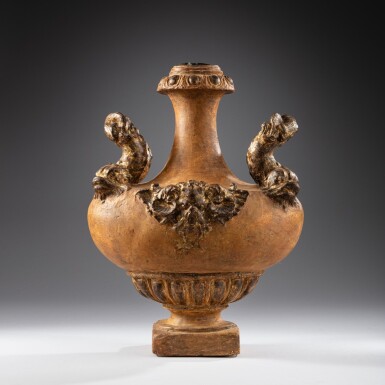
Attributed to Giovanni Battista Ciceri (? - 1715), after Giovanni Battista Foggini (1652 - 1725)
A double handled vase with grotesque masks
Estimate
6,000 - 8,000 EUR
Lot Details
Description
Attributed to Giovanni Battista Ciceri (? - 1715), after Giovanni Battista Foggini (1652 - 1725)
Florence, circa 1680
A double handled vase with grotesque masks
parcel-gilt stucco, with an copper lining
48.5cm. high, 19⅛in.
This ceremonial vase is a testimony to the taste for sumptuous decorative arts in Florence during the reign of Cosimo III (1642–1723), and the last Grand Dukes of Tuscany.
Its characteristic bulbous shape, with a long neck ending in a frieze border alternating ovals and darts, and its decoration of grotesque masks and handles in the form of two intertwined dolphins, are a synthesis of ancient decorative vocabulary and Roman Baroque models.
A prolific sculptor, architect and ornamentalist, Giovanni Battista Foggini epitomises the height of Florentine Baroque. His style is a skillful combination of Roman models, which he absorbed during his training with Ciro Ferri and Ercole Ferrata, and a Tuscan Mannerist heritage, dominated by the refined art of Giambologna. Foggini left his mark on the Grand Ducal Manufactories of the Uffizi, which specialised in the production of sumptuous objects in gilt bronze, semi-precious stones, silver and stucco. Under his direction, the Grand Ducalal Manufactories reached their peak and their products spread throughout the courts of Europe.
In a study on the present vase, David Lucidi attributes stucco casting to Giovanni Battista Ciceri, a sculptor from Ticino who was active in Florence until 1715 and a regular collaborator of Foggini. Under Foggini's direction, Ciceri participated in major stucco decoration projects, notably for the Feroni Chapel in the Santissima Annunziata and several Florentine palaces, including the Medici Palace.
Similarities are worth highlighting between the present vase and several drawings of ornaments by Foggini in the Uffizi, the Metropolitan Museum of Art and the J. Paul Getty Museum. The shape is particularly comparable to a drawing by Foggini in the Gabinetto disegni e stampe degli Uffizi (inv. no. G.F.S. 154594; cf. L. Monaci, op. cit., no. 81), and an urn by the same, with a partially gadrooned body, published by Bellesi and Visonà (op. cit., p. 329, figs. 27-28). A parallel should also be drawn with the ornamental works of Massimiliano Soldani Benzi, another protégé of Cosimo III de' Medici and Foggini's fellow student in Rome, particularly in the dolphin shape, a leitmotif in his work. This parallel testifies to a common inspiration and formal language within the Florentine Baroque school.
A marble example, with an almost identical decoration, was sold by Sotheby's London on 3 December 2014, attributed to the circle of Giovanni Battista Foggini (lot 108).
A complete study of this vase, carried out by David Lucidi on 30 May 2022, is available on request.
RELATED LITERATURE
L. Monaci, Disegni di Giovan Battista Foggini (1652-1725), cat. Gabinetto disegni e stampe degli Uffizi, Florence, 1977, n° 81;
G. Pratesi, Repertorio della scultura Fiorentina del seicento e settecento, Florence, 1993, fig. 225;
S. Bellesi, M. Visonà, Giovacchino Fortini. Scultura architettura decorazione e committenza a Firenze al tempo degli ultimi Medici, Florence, 2008, pp. 310-311, 329.
You May Also Like










